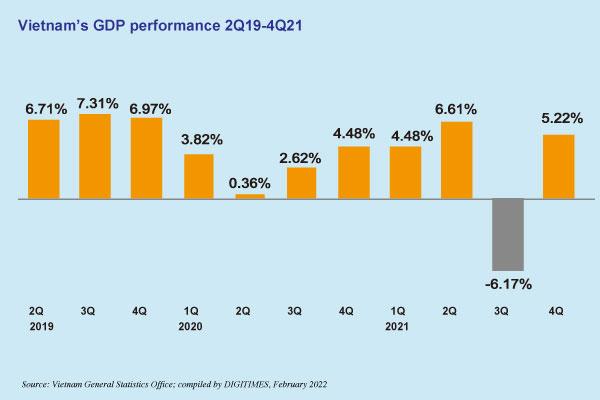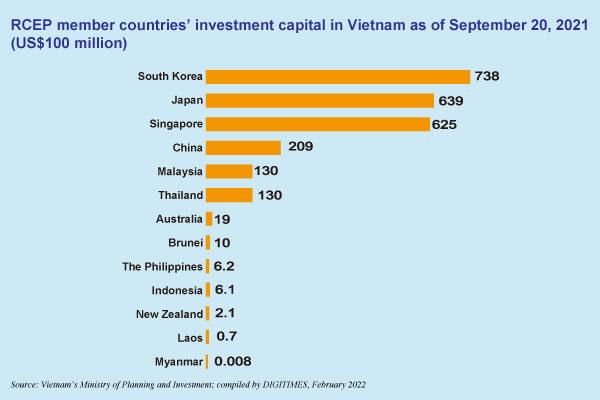Despite challenges posed by the COVID-19 pandemic, Vietnam remains an attractive location for manufacturers that seek relocation from China, and it is gaining advantages with the Regional Comprehensive Economic Partnership (RCEP) agreement taking effect.
The average labor cost in Vietnam is US$2.99 per hour, lower than US$6.5 per hour in China. The relatively low manufacturing costs in Vietnam make it appealing for foreign investment. The RCEP, a 15-country free trade agreement (FTA) that entered into force on January 1, 2022, is considered a boon for Vietnam.
Vietnam's GDP ranks the world's 40th and the 4th among its ASEAN peers. The country has beat many IT powers to become the world's second in terms of manufacturing and cellphones exports. Meanwhile, it ranks 9th in exporting and outsourcing electronics products and 6th in computer games. These figures show that Vietnam is emerging as a strong ICT power.
In the automotive manufacturing sector, Vietnam is obviously steering toward EV development. It is forecast that by 2030 Vietnamese would purchase 1 million cars every year, with the EV ratio expected to rise. By 2030, 30% of the global auto sales would be contributed by EVs and hybrid electric cars, Frost & Sullivan estimated. The changes in the auto production supply chains also provide Vietnamese firms more opportunities to get involved in EV component production.
As the US and European countries were hit hard by the COVID-19, Vietnam was no exception. The country's GDP in Q321 registered a minus 6.17%, its first negative growth since 2000. A record high of 1.8 million people in Vietnam was jobless, with its unemployment rate hitting 3.98%—worse than 2.73% of 2020. In 2021, more than 90,000 companies exited the market in Vietnam.
Nonetheless, the global supply chain is shifting toward Vietnam, partly because of China-US trade rivalry. More and more foreign firms look to invest in ASEAN countries or alternative markets, among which Vietnam emerges as an efficient choice. However, it is difficult for Vietnam to take over all manufacturers leaving China given it is not as large as China.
In 2021, foreign direct investment (FDI) in Vietnam reached US$31.15 billion, a 9.2% year-on-year. While the figure is lower than US$38 billion recorded in 2019, it is still viewed as a positive performance when the pandemic is factored in, showing that foreign investors were confident about Vietnam.
Vietnam's electronics industry is playing an ever more important role in the country's economy. The industry's exports collected more than US$36.56 billion in revenues during the first nine months of 2021. Driven by strong external demand, the country's consumer electronics industry will continue to expand. With its growing consumption, population, and economic modernization, Vietnam is one of the Asia-Pacific countries that are gaining strength.

Credit: DIGITIMES
Transnationals swarm to Vietnam
Prior to COVID-9 outbreaks, Vietnam has lured many foreign firms relocating under the impact of China-US trade friction and rising costs in China. Cellphones, TVs, cameras, electrical equipment, IC, and micro-parts are the main products exported by Vietnam, showing its crucial role in the global supply chain. Samsung Electronics produces about 180 million electronic devices every year, including smartphones, TVs, and refrigerators, while Vietnam accounts for 60% of the company's global devices production.
Samsung has grabbed several telecoms and 5G infrastructure bids that are worth billions of US dollars each, but few people know 90% of its equipment are made in Vietnam, according to industry sources.
In August 2021, Vietnam granted a license to South Korea's LG Display, allowing the company to raise its investment in the northern port city of Haiphong by US$1.4 billion. Thanks to the license, LG's OLED panels production in the port city will grow from 9.6-10.1 million to 13-14 million every month. That also brings LG's total investments in Vietnam to US$4.65 billion, mainly devoted to POLED screens for mobile devices, OLED for TVs and LCD screens.
In 2020, Hon Hai Technology Group's (Foxconn) investment in Vietnam reached US$1.5 billion. The company poured US$ 700 million more into the country as it hired 10,000 more workers there. Japanese firms such as Sharp, Nintendo, Komatsu, and China's Lenovo Group have also announced their plans to enter Vietnam or expand their businesses there. The US-based firm Qualcomm also opted for Vietnam to build its first R&D center in Southeast Asia. In 2022, more enterprises from across Europe, the US, and Asia would find their ways into Vietnam, the Vietnam Association of Foreign Invested Enterprises (VAFIE) estimated.
RCEP a boon for Vietnam
The RCEP is expected to channel more investment and international resources to Vietnam.
South Korea, Japan, and Singapore—the top three foreign investors in Vietnam—are expected to boost investment in Vietnam and other countries covered by the trade pact. As of September 20, 2021, Vietnam has attracted US$91.38 billion of investment capital from other ASEAN members.
Indonesia, Malaysia, Thailand, and Vietnam would be the main beneficiaries of RCEP; each would collect US$2-4 billion more every year by 2030, the Peterson Institute for International Economics indicated. FocusEconomics projected that Vietnam would benefit more from RCEP than other ASEAN members, possibly because its competitive exports industry would fit more closely with the region's value chain.
The RCEP enables signatories to negotiate tariffs and rules of origin, so it is deemed valuable for the whole ASEAN economy. Labor-intensive industries, such as manufacturing, will benefit from relocating to ASEAN countries, especially Vietnam, where the labor costs are competitive.
Vietnam sees its FTA participation as a tool to bolster its economic power and financial security. It will advance from manufacturing low-end products to supplying high-tech electronics, machinery, vehicles, and medical equipment.

Credit: DIGITIMES
Entry into global value chain
Overall, Vietnam's positive economic performances buffered some negative effects of the pandemic, allowing its supply chain to maintain resilience. The RCEP will enable Vietnam to further boost its trade volume and quality, diversify partnerships and take a bigger part in the global value chain.
However, financial services company Jefferies noted that investors still lack confidence in the global industry and value chain, citing decreases in the number of new projects involving electronics, vehicles, chemical engineering that bear on the global value chain.
Many countries have stepped up efforts to attract foreign investment, and yet global mergers are declining. These are also factors that might affect Vietnam's appeal for foreign investors in 2022.


